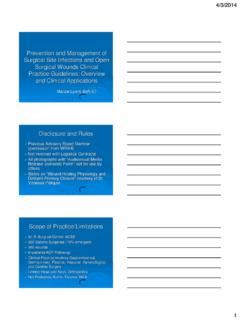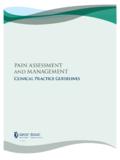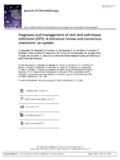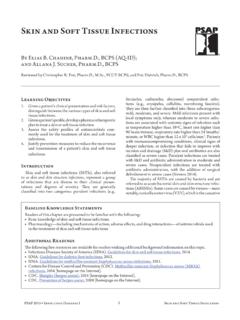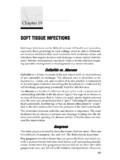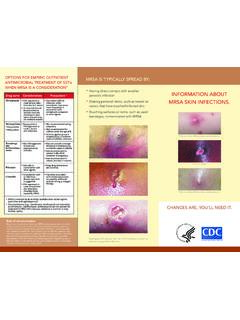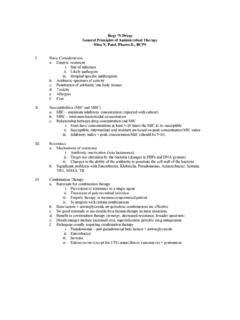Transcription of McGreer’s Definitions for Healthcare Associated Infections ...
1 McGreer s Definitions for Healthcare Associated Infections for Surveillance for Long Term Care Facilities Appendix B McGeer, A., Campbell, B., et al. Definitions of Infection for surveillance in long term care facilities. AJIC; 1991; 19(1):1-7 Operational Directive: Infection surveillance: Reviewed May 16, 2012 and Approved June 15, 2012 RESPIRATORY TRACT INFECTION Common cold syndromes/pharyngitis The resident must have at least two of the following signs or symptoms: Runny nose or sneezing Stuffy nose ( congestion) Sore throat or hoarseness or difficulty in swallowing Dry cough Swollen or tender glands in the neck (cervical lymphadenopathy) (Note: Fever may or may not be present. Symptoms must be new and care must be taken to ensure symptoms are not caused by allergies) Influenza-like illness (Manitoba Health 2006) Acute onset of respiratory illness with cough and fever and one or more of the following symptoms: (Note: fever or feverishness with chills may not be prominent in the elderly) Sore throat Arthralgia Myalgia Prostration Pneumonia Both of the following criteria must be met: Interpretation of a chest radiograph as demonstrating pneumonia, probable pneumonia, or the presence of an infiltrate.
2 If a previous radiograph exists for comparison, the infiltrate should be new. The resident must have a least two of the signs and symptoms described under other lower respiratory tract Infections . Other lower respiratory tract infection (bronchitis, tracheobronchitis) The resident must have at least three of the following signs or symptoms: New or increased cough New or increased sputum production Fever (>38 C) Pleuritic chest pain New or increased physical findings on chest examination (rales, rhonchi, wheezes, bronchial breathing) One of the following indications of change in status or breathing difficulty: new/increased shortness of breath or respiratory rate >25 per minute or worsening mental or functional status. URINARY TRACT INFECTION Urinary tract infection includes only symptomatic urinary tract Infections . Surveillance for asymptomatic bacteriuria (defined as the presence of a positive urine culture in the absence of new signs and symptoms or urinary tract infection) is not recommended, as this represents baseline status for many residents.
3 Symptomatic urinary tract infection One of the following criteria must be met: The resident does not have an indwelling urinary catheter and has at least three of the following signs and symptoms: Fever (>38 C) or chills New or increased burning pain on urination, frequency or urgency May be new or increased incontinence New flank or suprapubic pain or tenderness Change in character of urine [may be clinical ( , bloody urine) or as reported by the laboratory (new pyuria or microscopic hematuria). For laboratory changes a previous urinalysis must have been negative]. Worsening of mental or functional status The resident has an indwelling catheter and has at least two of the following signs or symptoms: Fever (>38 C) or chills New flank or suprapubic pain or tenderness Change in character of urine [may be clinical( , bloody urine)or as reported by the laboratory (new pyuria or microscopic hematuria).]
4 For laboratory changes a previous urinalysis must have been negative] Worsening of mental or functional status EYE, EAR, NOSE AND MOUTH INFECTION Conjunctivitis One of the following criteria must be met: Pus appearing from one or both eyes, present for at least 24 hours. New or increased conjunctival redness, with or without itching or pain, present for at least 24 hours (also known as pink eye ) Ear Infection One of the following criteria must be met: Diagnosis by a physician or nurse practitioner of any ear infection New drainage from one or both ears. (Non-purulent drainage must be accompanied by additional symptoms, such as ear pain or redness). Mouth and perioral infection Oral and perioral Infections , including oral candidiasis, must be diagnosed by a physician or a dentist. Sinusitis Diagnosis of sinusitis must be made by a physician.
5 SKIN AND SOFT TISSUE INFECTION Cellulitis/soft tissue/wound infection One of the following criteria must be met: Pus present at a wound, skin, or soft tissue site. The resident must have four or more of the following signs or symptoms: fever (>38 C) or worsening mental/functional status; and/or the presence of new or increasing (at the affected site): heat redness swelling tenderness or pain serous drainage Fungal skin infection The resident must have both: Maculopapular rash Either physician diagnosis or Laboratory confirmation. Herpes simplex and herpes zoster infection The resident must have both: Vesicular rash and Either physician diagnosis or Laboratory confirmation. Scabies The resident must have both: Maculopapular and/or itching rash and Physician diagnosis.
6 Gastrointestinal Tract Infection Gastroenteritis One of the following criteria must be met: Two or more loose or watery stools above what is normal for the resident within a 24 hour period. Two or more episodes of vomiting in a 24-hour period. Both of the following: Stool culture positive for a pathogen (Salmonella, Shigella, verotoxigenic E. coli, Campylobacter) or a toxin assay positive for C difficile toxin and at least one symptom or sign compatible with gastrointestinal tract infection (nausea, vomiting, abdominal pain or tenderness, diarrhea). SYSTEMIC INFECTION Primary bloodstream infection One of the following criteria must be met: Two or more blood cultures positive for the same organism. A single blood culture documented with an organism thought not to be a contaminant and at least one of the following: fever (> 38 C) new hypothermia (< C, or does not register on the thermometer being used) a drop in systolic blood pressure of > 30mm Hg from baseline worsening mental or functional status Unexplained febrile episode The resident must have documentation in the medical record of fever (>38 C) on two or more occasions at least 12 hours apart in any 3-day period, with no known infectious or non-infectious cause.
7

